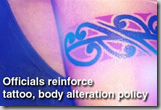That’s how Tom Ricks characterizes the recent actions when the Navy relieved the CO, CMC, and transferred the XO of USS JAMES WILLIAMS (DDG 95). No court-martials of the leadership are  anticipated. However, as Kate Wiltrout’s article points out, there have been quite a few disciplinary actions. The number of enlisted khaki involved seems quite extraordinary for the size of this ship’s crew.
anticipated. However, as Kate Wiltrout’s article points out, there have been quite a few disciplinary actions. The number of enlisted khaki involved seems quite extraordinary for the size of this ship’s crew.
Here is Kate Wiltrout’s article in The PilotOnline.
The commanding officer and highest-ranking enlisted sailor aboard the Norfolk-based destroyer James E. Williams were removed Friday in the wake of a fraternization scandal that erupted on a recent deployment.
 Court-Martial Trial Practice Blog
Court-Martial Trial Practice Blog


